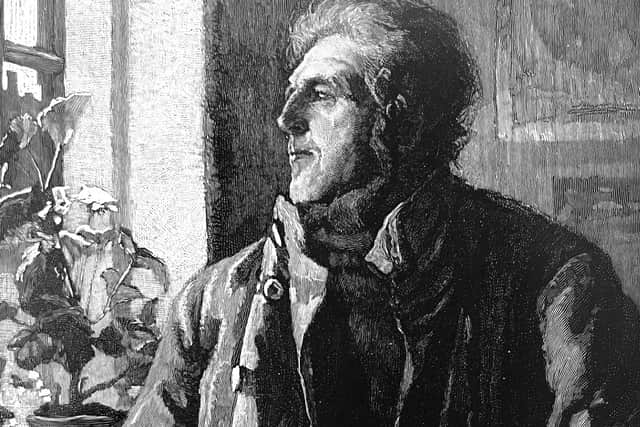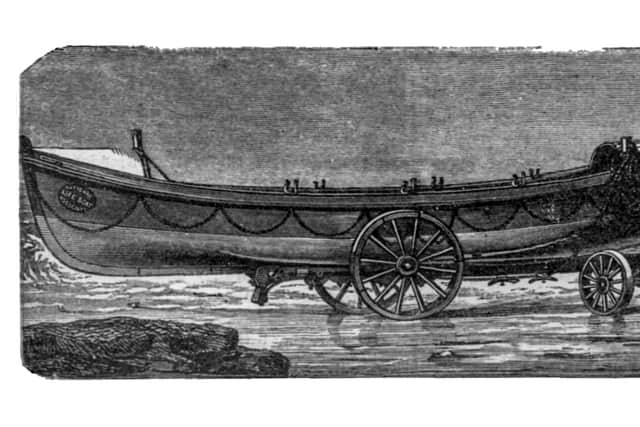RNLI 200: looking back to the first ever Staithes lifeboat, Hannah Somerset
and live on Freeview channel 276
In 1874, it was decided that a lifeboat station in the village of Staithes would be beneficial, particularly to safeguard the Staithes fishing fleet.
Locals offered immediate support to the institution.
On 17 May 1875, a number of Staithes men made the journey to Loftus.


Advertisement
Hide AdAdvertisement
Hide Ad]The lifeboat was to be delivered by rail with the North Eastern Railway conveying the boat free of charge.
Having been placed on a launching carriage the boat was dragged to Loftus Marketplace, posed opposite the Golden Lion Hotel, and a short ceremony took place.
This included the passing around of a hat for donations, which was generously responded to, before six strong horses were attached to the boat carriage and the cavalcade made for Staithes.
On June 1, 1875 the inauguration of the lifeboat station took place, where a large crowd stood vigil as the lifeboat was brought from the lifeboat house, for the ceremony, and then launched and trialled by its crew.


Advertisement
Hide AdAdvertisement
Hide AdJoseph Ben (Joe Ben) Verrill was appointed Coxswain of the lifeboat, by the crew.
The boat was a 32ft x 8ft 10 oared self-righting lifeboat built by Woolfe and Sons, with the expense being met by a legacy left by Hannah Yates.
Named Hannah Somerset, the lifeboat served at Staithes from 1875 to 1887, launching nine times and saving 15 lives.
Then, as now, men and women from Staithes and the surrounding villages were a part of the story of the lifeboat, volunteering their time to save lives at sea.
Advertisement
Hide AdAdvertisement
Hide AdOn March 15, 1876 came the lifeboat’s first service launch, her crew coming to the aid of the steamer Bebside.
While on voyage from Newcastle to London, with a cargo of coal, a north westerly gale with a heavy sea running resulted in the ship being driven aground and wrecked near Cowbar Steel.
A local fisherman had put off in his coble at his own peril and rescued three crew from the steamer.
The lifeboat launched and Coxswain Joe Ben Verrill took the lifeboat alongside the steamer and with great skill, the remaining 15 crew embarked and were taken to safety.
Advertisement
Hide AdAdvertisement
Hide AdBy March 18, the ship had mostly broken up, with the iron of the outside shell, the engine and fittings all that remained and the items which had washed ashore were being auctioned that afternoon.
Coal from the steam ships cargo is said to have been most welcome, with inhabitants of the village collecting the coal from the shore.
On April 10, 1876, as reported by the Whitby Gazette, the cobles of Staithes had set out fishing.
A ‘tremendous heavy sea’ was the precursor to the village being enveloped in a storm, and it was decided as the sea rose to launch the lifeboat.
Advertisement
Hide AdAdvertisement
Hide AdJoe Ben Verrill, Simeon Robinson, and Richard Seymour were among the crew to launch.
Robinson was a fisherman, and an accomplished rower – having competed in coble races against fishermen in Redcar, Seymour is said to have been a ‘veteran salt’ who when necessity required, despite having retired and laid on his oars for several years, ‘showed his companions that he was still able to ply them.’
The lifeboat met with two cobles and their crews, and they were assisted safely back to the village.
The final boat needing assistance was the Charles M Palmer, which belonged to Edward Verrill and Co.
Advertisement
Hide AdAdvertisement
Hide AdWith a sea running ‘mountains high’ a crowd assembled on the shore; fearing that the lifeboat would not make it back to shore, let alone the fishing boat.
The villagers watching with intense anxiety saw the lifeboat get to the windward side of the casualty vessel and acting as a breakwater to the vessel the lifeboat escorted them to shore.
While now Staithes and Runswick RNLI lifeboat crews still receive call outs to the shores of Boulby cliffs the dynamic of rescues here have transitioned.
With the most likely call out being to tidal cut offs, where people have walked north from the village and been caught out by a rapidly encroaching tide.
Advertisement
Hide AdAdvertisement
Hide AdHowever, there is still a risk to vessels of running aground on the coast around Staithes and Runswick.
Luke Hutchinson, now helm at Staithes and Runswick RNLI lifeboat, remembers an earlier rescue.
"The call came in at about 3pm, a 60m steel yacht had run aground at Hummersea with three people on board.
"I went ashore and assisted the coastguard to extract the casualties via land.
Advertisement
Hide AdAdvertisement
Hide Ad"With a tow line established Staithes and Runswick lifeboat, with the assistance of Whitby lifeboat, towed the vessel off the shore as the tide pushed in and it had refloated.’
The boat's other services were mainly in safeguarding the fishing fleet of Staithes and assisting their return to the village.
The final service launch of the Hannah Somerset was to be in 1881.
On August 6, 1883, six lifeboats came to Whitby to join the Regatta, an annual event, and Staithes lifeboat entered the National Lifeboat Race, with prizes for first, second and third place.
Advertisement
Hide AdAdvertisement
Hide AdThe race was about two and a half miles from Whitby pier end to Upgang and back and was won by the Staithes volunteer crew in the Hannah Somerset.
The Yorkshire Gazette said the Staithes boat was the first to round the post off Upgang, and she retained her advantage to the end.
In 1885, in Joe Ben Verrill's last year as Coxswain the boat and crew came second in the same race.
Joe Ben Verrill retired as Coxswain in 1886, succeeded by Charles Horne, and in 1887 a new lifeboat was sent to Staithes, ending Hannah Somerset's 12 years service at Staithes.
Advertisement
Hide AdAdvertisement
Hide AdToday, as it was in 1875, Staithes and Runswick RNLI lifeboat is supported by generous donations – the current lifeboat in Staithes was funded by a legacy donated to the RNLI, along with three more Atlantic 85 lifeboats.